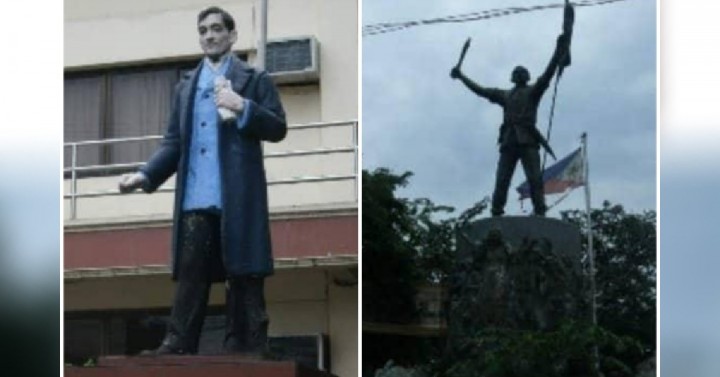Lifestyle
Oddities of Rizal, Bonifacio monuments in Novaliches

HEROES. The monuments of national hero Dr. Jose Rizal (left) and Katipunan founder Andres Bonifacio found in Novaliches in these photos taken in 2018. The two monuments were erected nine decades apart. (Photos by Leilani Samonte-Junio via PNA)
MANILA – Where in the Philippines can you find monuments of the national hero Dr. Jose Rizal and Katipunan founder Andres Bonifacio located just a few meters apart and appearing to be walking away from each other, perhaps because of differences in opinion and principle?
If you want to see this, then go to the old poblacion (settlement) of the former town of Novaliches–first a part of the old Bulacan province (1855-1858), then of Manila province (1858-1901), of Rizal province (1901-1903), and finally divided between Quezon City and Caloocan since 1948 until at present.
The two monuments seem to be a dramatization of the supposed disagreement between the two heroes about the premature launching of the revolution against Spanish rule in the Philippines in 1896.
History shows that Rizal was not in favor of Bonifacio’s plan to revolt due to the lack of arms at that time.
Both located at the old Novaliches poblacion or plaza, the two monuments were erected nine decades apart — the one memorializing Rizal in 1901 and that of Bonifacio’s in 1999 or 98 years later.
Although not intentional, the positioning of the two monuments facing different directions, about 50 meters apart at a 30-degree angle, made it appear that the country’s two leading heroes were in disagreement and walking away from each other.
Rizal’s monument is situated in front of the three-story Novaliches Proper barangay hall along Buenamar Ave.
On the other hand, the Bonifacio memorial is located near the Novaliches branch of the Quezon City Public Library along Quirino Highway.
The Bonifacio statue, holding a bolo in the right hand and the Katipunan flag in the left one, is facing eastward or toward the neighboring towns of Montalban (now Rodriguez) and San Mateo in Rizal.
The statue of Dr. Rizal, in an overcoat and holding a bunch of manuscripts, is facing westward or toward the former Bulacan town of Polo, now Valenzuela City named after Dr. Pio Valenzuela, Bonifacio’s close friend and co-organizer of the Katipunan.
Unfortunately, the two monuments cannot now be viewed at the same time because of obstructions caused by the erection of government structures between them, including a portion of the local barangay hall itself.
Visiting the two monuments on the eve of the celebration of Dr. Rizal’s 161st birthday on June 19, this writer was reminded of the historical accounts of the differing stand between Rizal and Bonifacio regarding the launching of the August 1896 uprising against Spain.
In effect, I thought that the contrasting positions of the two heroes’ monuments could best illustrate their “being at odds with each other” on the matter of obtaining independence from Spain during their youthful years–Rizal at age 35 and Bonifacio at 33.
According to the book “Minutes of the Katipunan” (English edition) published in 1996 by the National Historical Institute, now National Historical Commission of the Philippines (NCHP), in time for the centennial celebration of the Philippine Revolution (1896-1996), Bonifacio sent Dr. Valenzuela on June 15, 1896 to seek the advice of Dr. Rizal regarding the planned armed revolution against Spain.
Rizal was then in exile in Dapitan in Mindanao.
On June 21, 1896, Valenzuela reported to Bonifacio about Rizal’s disagreement with the planned uprising, stressing the need for adequate preparations and arms against the enemies, and recruiting war tactician Antonio Luna as a general in the revolutionary organization.
Despite Rizal’s objection, Bonifacio and his brave Katipuneros, who could no longer bear the tyrannous foreign rule, launched the armed struggle in August 1896. The rest is now history.
Dr. Rizal was executed on Dec. 30, 1896, by a Spanish firing squad at Bagumbayan, now Luneta or Rizal Park in Manila.
On the other hand, Bonifacio himself was killed in Maragondon, Cavite on May 10, 1897, by a faction of the Katipunan he founded on July 7, 1892.
(Severino Samonte is a retired executive editor of the Philippine News agency and still regularly contributes news articles and features)





















